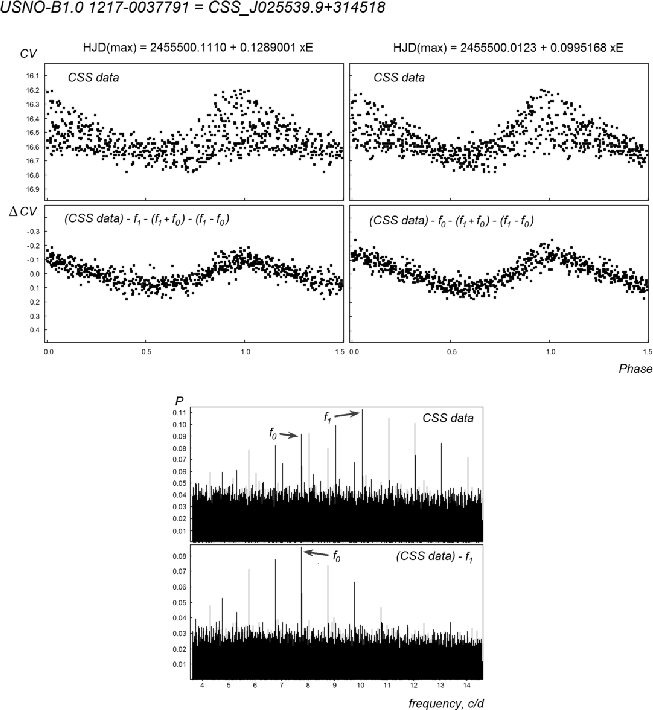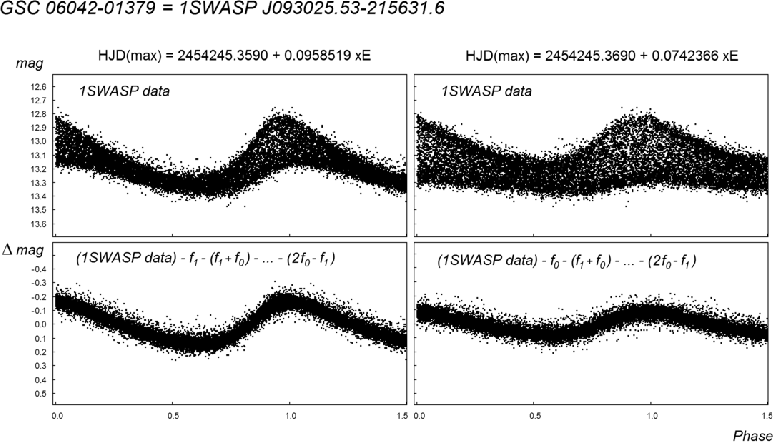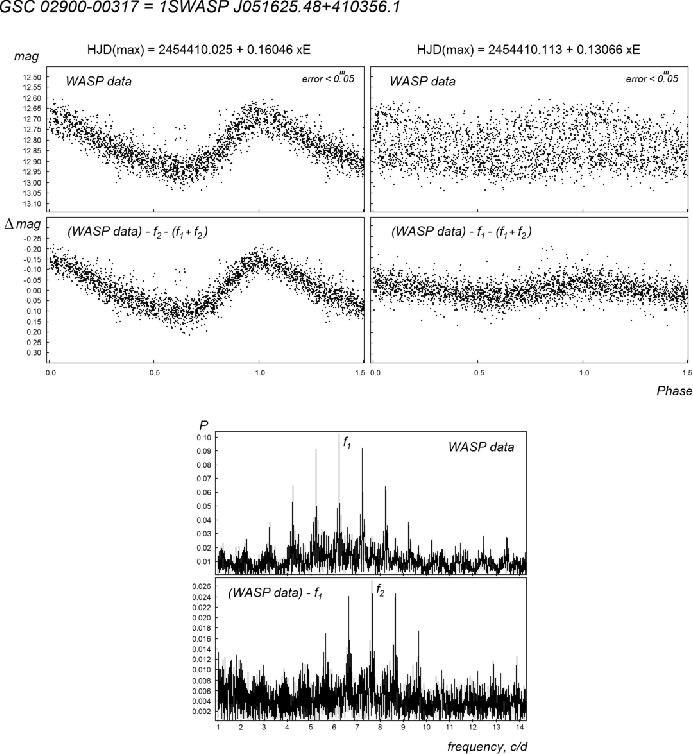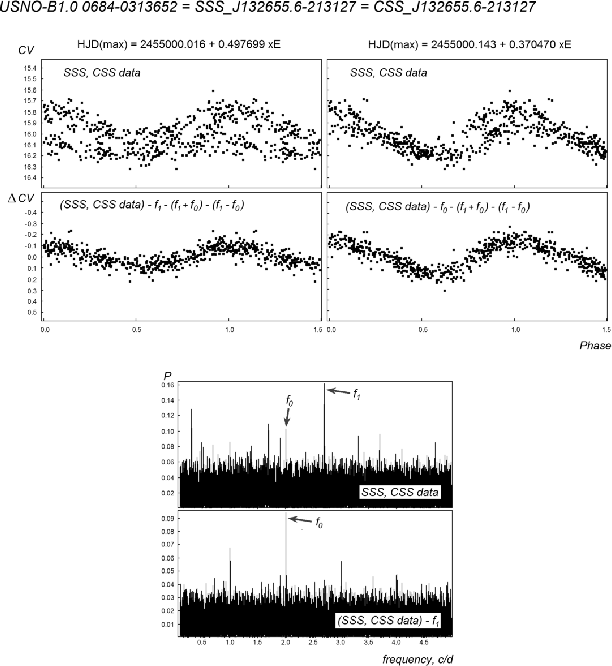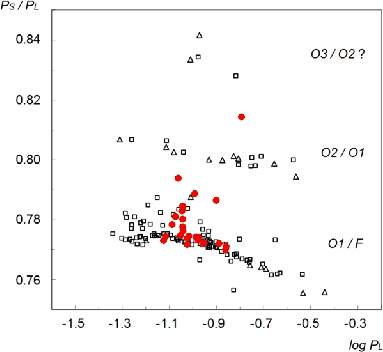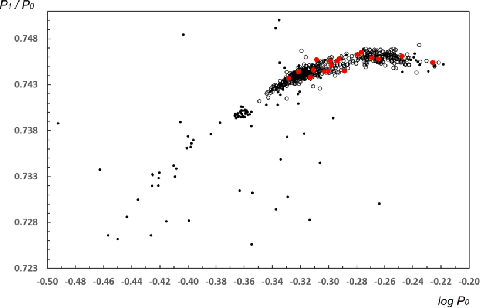|
Peremennye Zvezdy (Variable Stars) 38, No. 1, 2018 Received 15 January; accepted 12 April.
|
Article in PDF |
A Study of Double-Mode Variables
A. V. Khruslov
Sternberg Astronomical Institute, Moscow State University, Universitetskij pr. 13, Moscow 119992, Russia; khruslov@bk.ru Institute of Astronomy, Russian Academy of Sciences, Pyatnitskaya str. 48, Moscow 119017, Russia
|
I present a detection of 44 new double-mode variable
stars, of which 25 variables are high-amplitude |
1. Introduction
I studied 44 double-mode variable stars using the available photometric archive data: the Catalina Sky Surveys1(CSS, Drake et al. 2009) and the Wide Angle Search for Planets2 (1SWASP, Butters et al. 2010). Additionally, in two cases, I used data of the All-Sky Automated Survey for Supernovae3and its catalog of new variables4 (ASAS-SN, Shappe et al. 2014, Kochanek et al. 2017).
The SuperWASP observations are available as FITS tables, which were converted into ASCII tables using the OMC2ASCII5program as described by Sokolovsky (2007).
I performed my search for candidate double-mode stars using the Catalina surveys periodic variable star catalog (Drake et al. 2014) and the Catalina surveys southern periodic variable star catalog (Drake et al. 2017). I studied the variables designated as HADS and RRC type stars in these lists and made a sample of stars with the phased light curve showing a somewhat enhanced scattering. For double-mode candidates, I analyzed all the observations using Deeming's method (Deeming 1975) implemented in the WinEfk code6written by V.P. Goranskij. Besides, I confirmed variability of one previously suspected star and detected its double periodicity: RR_13 was suspected as an RR Lyrae star by Ivezic et al. (2000) on the base of its colors and variability properties. In addition, I discovered variability of two stars using the 1SWASP data and APASS catalog7.
In five cases (DS_07, DS_16, DS_18 and RR_08, RR_15), the periods presented in the Catalina surveys periodic variable star catalog were found to be wrong.
Most of the double-mode variables we studied experience radial pulsations in the first-overtone and fundamental modes. One star is possibly pulsating in the first- and second-overtone modes. For two HADS stars, I detected possible additional non-radial pulsations.
In this paper, the following designation are used for the variables: for the stars in the HADS(B) section, DS_01 ... DS_24 (see Tables 1-3); for the stars in the RR(B) section, RR_01 ... RR_19 (see Tables 5-7); one star, GSC 02693-00926, is called by its catalog name.
For RR(B) stars, this paper is a continuation of our publication series (Khruslov 2014a, 2015ab). For HADS(B) stars, this paper supplements our previously published articles (Khruslov 2009, 2011, 2014b, 2015c).
The light curves, finding charts, and data (from CSS, SSS, MLS,
1SWASP, ASAS-SN surveys) are available online in the html version
of this paper as a zip-archive. The light curves are given in the
format displayed in Fig. 1. Top panels present data folded with
the fundamental-mode and first overtone periods (in the case of
GSC 02693-00926, the first and second overtone periods). Bottom
panels show the same curves after prewhitening the other
oscillation (if ![]() ,
, ![]() and other interaction
frequencies or non-radial frequencies were excluded, it is also
noted). These light curves are given for all data series. Along
with the light curves, we present power spectra of the double-mode
variables, for the raw data and after subtraction of the dominant
mode (fundamental or first-overtone oscillations). The structure
of the power spectra shows that the secondary periods are real.
and other interaction
frequencies or non-radial frequencies were excluded, it is also
noted). These light curves are given for all data series. Along
with the light curves, we present power spectra of the double-mode
variables, for the raw data and after subtraction of the dominant
mode (fundamental or first-overtone oscillations). The structure
of the power spectra shows that the secondary periods are real.
The radial pulsation modes were identified by the period ratio
(
![]() ). The typical period ratio of
pulsations in the fundamental and first-overtone modes (F/1O) is
). The typical period ratio of
pulsations in the fundamental and first-overtone modes (F/1O) is
![]() for RR(B) stars and
for RR(B) stars and
![]() for HADS(B) stars. The typical period ratio of pulsations in the
first- and second-overtone modes (1O/2O) is
for HADS(B) stars. The typical period ratio of pulsations in the
first- and second-overtone modes (1O/2O) is
![]() .
.
The stars were identified in the USNO-B1.0 (Monet et al. 2003) and GSC (Morrison et al. 2001) catalogs. The tabulated coordinates of the variables were drawn from either the GSC2.3 (Lasker et al. 2008) or 2MASS (Skrutskie et al. 2006) catalogs. In the case of RR_19, the coordinates are from the UCAC4 catalog (Zacharias et al. 2012).
2. New HADS(B) stars, F/1O
I detected 24 HADS(B) stars pulsating in the fundamental and
first-overtone modes. Their magnitudes are between 12![]() 7 and
17
7 and
17![]() 7 in the
7 in the ![]() system. The highest peak-to-peak amplitude of
light variations is 0
system. The highest peak-to-peak amplitude of
light variations is 0![]() 99 (DS_17). The fundamental-mode periods
are between 0
99 (DS_17). The fundamental-mode periods
are between 0![]() 074 and 0
074 and 0![]() 138.
138.
Information on these stars is presented in Tables 1-3. The light curves and power spectra for one of the stars (DS_04) are displayed in Fig. 1. Table 1 contains equatorial coordinates (J2000); magnitudes at maximum and minimum in the Catalina surveys photometric system; star numbers from the USNO-B1.0 or GSC catalogs; information on the source of data used in this study (c: CSS; m: MLS; s: SSS, w: 1SWASP, a: ASAS-SN). For magnitudes at maximum and minimum in the 1SWASP system, see Comments to Table 1.
In most cases, I derived light elements from Catalina surveys data. 1SWASP data were helpful for improving the light elements and detecting additional oscillations. An example of 1SWASP light curves is displayed in Fig. 2 (DS_11).
Table 2 presents light elements of fundamental and first-overtone
oscillations: the fundamental period ![]() , the first-overtone
period
, the first-overtone
period ![]() , the fundamental and first-overtone mode epochs of
maxima, the period ratio
, the fundamental and first-overtone mode epochs of
maxima, the period ratio ![]() . Additional information on
some of the stars can be found in Comments to Table 2.
. Additional information on
some of the stars can be found in Comments to Table 2.
Table 2a contains periods of the interaction frequencies ![]() (
(![]() ),
), ![]() (
(![]() ),
), ![]() (
(![]() ),
),
![]() (
(![]() ),
), ![]() (
(![]() ),
), ![]() (
(![]() ),
), ![]() (
(![]() ).
).
Table 3 presents semi-amplitudes of the oscillations, separately
for Catalina surveys and 1SWASP data: semi-amplitudes of the
fundamental mode (![]() ) and first-overtone (
) and first-overtone (![]() ) oscillations,
and of their interaction frequencies.
) oscillations,
and of their interaction frequencies.
For DS_02, DS_03, DS_11 and DS_14, we improved the light elements and detected additional interaction frequencies using 1SWASP data. The variability discovery of DS_06 used data from the 1SWASP survey and APASS catalog. In this case, only 1SWASP data are available.
| No. | Coordinates (J2000) | Name | Data | |
| 1 | 02 |
15 |
USNO-B1.0 1271-0037436 | c |
| 2 | 02 24 38.93 +26 21 01.6 | 13.36 - 13.83 | GSC 01774-01236 | cw |
| 3 | 02 37 22.96 +38 28 47.2 | 14.40 - 14.98 | GSC 02832-01221 | cw |
| 4 | 02 55 39.90 +31 45 18.7 | 16.20 - 16.78 | USNO-B1.0 1217-0037791 | c |
| 5 | 03 44 52.19 +17 16 34.6 | 15.27 - 15.76 | USNO-B1.0 1072-0051636 | c |
| 6 | 04 28 53.38 +43 15 10.9 | (see Comments) | USNO-B1.0 1332-0126848 | wa |
| 7 | 05 13 46.48 +06 59 24.2 | 16.09 - 16.66 | USNO-B1.0 0969-0055157 | c |
| 8 | 07 26 43.58 +41 35 23.1 | 16.71 - 17.41 | USNO-B1.0 1315-0187511 | c |
| 9 | 08 22 37.42 +03 04 41.8 | 13.31 - 13.83 | GSC 00201-01923 | c |
| 10 | 08 56 36.42 -02 25 35.2 | 14.32 - 14.85 | GSC 04869-01051 | c |
| 11 | 09 30 25.52 -21 56 31.6 | 12.67 - 13.21 | GSC 06042-01379 | csw |
| 12 | 11 49 44.16 +18 51 28.1 | 16.89 - 17.60 | USNO-B1.0 1088-0197927 | c |
| 13 | 12 00 37.39 +12 28 05.3 | 16.76 - 17.66 | USNO-B1.0 1024-0244792 | c |
| 14 | 13 06 36.82 -35 46 23.0 | 13.99 - 14.74 | GSC 07262-00111 | sw |
| 15 | 15 45 18.61 +16 40 51.6 | 15.98 - 16.42 | USNO-B1.0 1066-0249103 | c |
| 16 | 16 22 43.63 +00 05 03.1 | 14.73 - 15.31 | GSC 00369-01308 | c |
| 17 | 16 28 18.88 +03 26 51.1 | 16.52 - 17.51 | USNO-B1.0 0934-0280421 | c |
| 18 | 17 46 43.81 +28 55 33.3 | 14.60 - 15.17 | GSC 02089-01468 | c |
| 19 | 18 44 25.40 -56 36 46.2 | 13.58 - 13.99 | GSC 08766-01800 | s |
| 20 | 19 41 49.54 -53 32 46.6 | 15.70 - 16.14 | USNO-B1.0 0364-0811436 | s |
| 21 | 20 55 40.03 -02 03 21.2 | 15.67 - 16.40 | USNO-B1.0 0879-0781144 | c |
| 22 | 20 59 10.15 -03 28 20.7 | 14.45 - 15.11 | GSC 05183-01938 | c |
| 23 | 21 26 09.20 +14 53 18.7 | 13.99 - 14.74 | USNO-B1.0 1048-0604416 | c |
| 24 | 23 56 59.35 +06 31 32.5 | 14.91 - 15.39 | GSC 00593-01336 | c |
Comments to Table 1:
DS_02. From 1SWASP data, 13![]() 27 - 13
27 - 13![]() 74.
74.
DS_03. From 1SWASP data, 14![]() 2 - 14
2 - 14![]() 9.
9.
DS_06. From 1SWASP data, 14![]() 4 - 15
4 - 15![]() 0;
0;
from ASAS-SN data, 14![]() 23 - 15
23 - 15![]() 08 (
08 (![]() ).
).
DS_11. From 1SWASP data, 12![]() 80 - 13
80 - 13![]() 41.
41.
DS_14. From 1SWASP data, 14![]() 1 - 15
1 - 15![]() 1.
1.
| No. | Epoch |
Epoch |
|||
| 1 | 0.1052902 | 0.0815073 | 2455500.0183 | 2455500.0520 | 0.7741 |
| 2 | 0.1015792 | 0.0801161 | 2455500.0440 | 2455500.0700 | 0.7887 |
| 3 | 0.11067530 | 0.08543985 | 2455500.0669 | 2455500.0217 | 0.7720 |
| 4 | 0.1289001 | 0.0995168 | 2455500.1110 | 2455500.0123 | 0.7720 |
| 5 | 0.0748235 | 0.0578434 | 2455500.0555 | 2455500.0587 | 0.7731 |
| 6 | 0.1371462 | 0.1055856 | 2454100.2017 | 2454100.2135 | 0.7699 |
| 7 | 0.1029720 | 0.0797190 | 2455500.0610 | 2455500.0130 | 0.7742 |
| 8 | 0.0903166 | 0.0702281 | 2455500.0515 | 2455500.0260 | 0.7776 |
| 9 | 0.0905480 | 0.0702981 | 2455500.0380 | 2455500.0110 | 0.7764 |
| 10 | 0.0882723 | 0.0683850 | 2455500.0686 | 2455500.0572 | 0.7747 |
| 11 | 0.0958519 | 0.0742366 | 2454245.3590 | 2454245.3690 | 0.7745 |
| 12 | 0.0896816 | 0.0702105 | 2455500.0300 | 2455500.0083 | 0.7829 |
| 13 | 0.0903184 | 0.0708550 | 2455500.0350 | 2455500.0432 | 0.7845 |
| 14 | 0.1379871 | 0.1063876 | 2455500.1150 | 2455500.0450 | 0.7710 |
| 15 | 0.0865396 | 0.0686981 | 2455500.0204 | 2455500.0017 | 0.7938 |
| 16 | 0.1051553 | 0.0812981 | 2455500.0995 | 2455500.0785 | 0.7731 |
| 17 | 0.1253521 | 0.0985880 | 2455500.1155 | 2455500.0320 | 0.7865 |
| 18 | 0.0815316 | 0.0634601 | 2455500.0548 | 2455500.0150 | 0.7780 |
| 19 | 0.0943743 | 0.0728273 | 2455500.0950 | 2455500.0585 | 0.7717 |
| 20 | 0.1110649 | 0.0857819 | 2455500.0980 | 2455500.0063 | 0.7724 |
| 21 | 0.0839438 | 0.0655573 | 2455500.0654 | 2455500.0550 | 0.7810 |
| 22 | 0.0762165 | 0.0590200 | 2455500.0193 | 2455500.0090 | 0.7744 |
| 23 | 0.0904151 | 0.0705390 | 2455500.0123 | 2455500.0060 | 0.7802 |
| 24 | 0.0946992 | 0.0732698 | 2455500.0363 | 2455500.0190 | 0.7737 |
Comments to Table 2:
DS_05. Double periodicity is confirmed in MLS data.
DS_07. Strong scattering of the phased light curve towards brighter magnitudes.
DS_15. The variability was discovered by Palaversa et al. (2013),
LINEAR 15289666. The variable was classified as a ![]() Sct or
SX Phe star with the period
Sct or
SX Phe star with the period
![]() . Drake et al. (2014)
independently detected the star's variability and gave the type
HADS with the period
. Drake et al. (2014)
independently detected the star's variability and gave the type
HADS with the period
![]() . The variable is actually a
HADS(B) star. It is difficult to determine the correct periods
because the frequencies are close to the relation
. The variable is actually a
HADS(B) star. It is difficult to determine the correct periods
because the frequencies are close to the relation
![]() . The ratio of the detected most probable periods (
. The ratio of the detected most probable periods (
![]() ) is typical not of the
) is typical not of the ![]() and
and ![]() periods but of
the
periods but of
the ![]() and
and ![]() periods. The one-day alias periods
periods. The one-day alias periods
![]() and
and
![]() are not excluded; their
period ratio,
are not excluded; their
period ratio,
![]() , is more typical.
, is more typical.
DS_21. An additional non-radial pulsation, ![]() (
(
![]() ,
, ![]() ), is possible.
), is possible.
DS_22. Two additional non-radial pulsations (quasi-equidistant
triplet) are possible: ![]() (
(
![]() ,
,
![]() ) and
) and ![]() (
(
![]() ,
,
![]() );
); ![]() ; beat period
; beat period
![]() ;
interaction frequency
;
interaction frequency ![]() (
(
![]() ,
,
![]() ). This result needs an independent
verification.
). This result needs an independent
verification.
| No. | |||||||
| 1 | 0.04594235 | 0.360844 | - | - | - | - | - |
| 2 | 0.0447901 | 0.379181 | 0.0310840 | - | - | - | - |
| 3 | 0.0482170 | 0.374715 | - | 0.0695756 | - | - | - |
| 4 | 0.0561592 | 0.436562 | - | - | - | - | - |
| 5 | 0.0326234 | 0.254889 | - | - | - | - | - |
| 6 | 0.0596571 | 0.458810 | - | - | - | - | - |
| 7 | 0.0449329 | 0.353021 | - | - | - | - | - |
| 8 | 0.0395077 | 0.315741 | - | - | - | - | - |
| 9 | 0.0395742 | 0.314342 | 0.02753848 | - | 0.127185 | - | - |
| 10 | 0.0385332 | - | - | - | - | - | - |
| 11 | 0.0418354 | 0.329194 | 0.0291237 | - | 0.135225 | 0.0267566 | - |
| 12 | 0.03938024 | 0.323378 | - | - | - | - | - |
| 13 | 0.0397057 | 0.328798 | 0.0275807 | - | - | - | - |
| 14 | 0.0600722 | 0.464556 | 0.0418521 | - | - | - | 0.0321122 |
| 15 | 0.03829673 | 0.333222 | - | - | - | - | - |
| 16 | 0.0458502 | 0.358335 | - | - | - | - | - |
| 17 | 0.0551854 | 0.461743 | 0.0383168 | - | - | - | - |
| 18 | 0.03568483 | 0.286310 | 0.02482110 | - | - | - | - |
| 19 | 0.04110613 | - | - | - | - | - | - |
| 20 | 0.0483999 | - | - | - | - | - | - |
| 21 | 0.0368099 | 0.299299 | - | - | - | - | - |
| 22 | 0.03326248 | 0.261581 | - | - | - | - | - |
| 23 | 0.0396249 | 0.320878 | 0.0275507 | - | - | - | - |
| 24 | 0.04130874 | 0.323789 | - | - | - | - | - |
| No. | CSS | WASP | ||||||||
| 1 | 0.067 | 0.103 | 0.027 | 0.013 | - | - | - | - | - | - |
| 2 | 0.111 | 0.040 | 0.023 | 0.023 | 0.011 | 0.104 | 0.046 | 0.023 | 0.018 | 0.009 |
| 3 | 0.053 | 0.129 | 0.026 | 0.022 | - | 0.056 | 0.130 | 0.027 | 0.031 | - |
| 4 | 0.086 | 0.113 | 0.031 | 0.040 | - | - | - | - | - | - |
| 5 | 0.111 | 0.053 | 0.016 | 0.019 | - | - | - | - | - | - |
| 6 | - | - | - | - | - | 0.097 | 0.091 | 0.040 | - | - |
| 7 | 0.083 | 0.100 | 0.033 | 0.044 | - | - | - | - | - | - |
| 8 | 0.142 | 0.063 | 0.036 | 0.035 | - | - | - | - | - | - |
| 9 | 0.123 | 0.069 | 0.032 | 0.038 | 0.012 | - | - | - | - | - |
| 10 | 0.137 | 0.049 | 0.020 | - | - | - | - | - | - | - |
| 11 | 0.128 | 0.068 | 0.029 | 0.036 | - | 0.146 | 0.080 | 0.033 | 0.037 | 0.012 |
| 12 | 0.132 | 0.067 | 0.041 | 0.043 | - | - | - | - | - | - |
| 13 | 0.127 | 0.107 | 0.046 | 0.045 | 0.021 | - | - | - | - | - |
| 14 | 0.247 | 0.038 | 0.034 | - | 0.015 | 0.295 | 0.054 | 0.038 | 0.024 | 0.025 |
| 15 | 0.107 | 0.041 | 0.022 | 0.023 | - | - | - | - | - | - |
| 16 | 0.134 | 0.067 | 0.031 | 0.023 | - | - | - | - | - | - |
| 17 | 0.203 | 0.108 | 0.051 | 0.056 | 0.031 | - | - | - | - | - |
| 18 | 0.165 | 0.054 | 0.032 | 0.034 | 0.016 | - | - | - | - | - |
| 19 | 0.139 | 0.030 | 0.017 | - | - | - | - | - | - | - |
| 20 | 0.089 | 0.050 | 0.021 | - | - | - | - | - | - | - |
| 21 | 0.126 | 0.073 | 0.033 | 0.046 | - | - | - | - | - | - |
| 22 | 0.209 | 0.033 | 0.018 | 0.024 | - | - | - | - | - | - |
| 23 | 0.157 | 0.085 | 0.046 | 0.042 | 0.024 | - | - | - | - | - |
| 24 | 0.124 | 0.060 | 0.021 | 0.017 | - | - | - | - | - | - |
Comments to Table 3:
DS_03. According to CSS data,
![]() .
.
DS_06. According to ASAS-SN data, ![]() ,
, ![]() ,
,
![]() ,
,
![]() in
in ![]() -band.
-band.
DS_09. According to CSS data,
![]() .
.
DS_11. According to 1SWASP data,
![]() and
and
![]() .
.
DS_14. According to 1SWASP data,
![]() .
.
3. GSC 02900-00317, a 1O/2O HADS(B) star
I discovered variability of GSC 02900-00317 (
![]() , J2000)
from 1SWASP data and the APASS catalog. According to 1SWASP data
(1SWASP J051625.48+410356.1), GSC 02900-00317 is a double-mode
HADS star probably pulsating in the first- and second-overtone
modes. The variability range in the 1SWASP data is
, J2000)
from 1SWASP data and the APASS catalog. According to 1SWASP data
(1SWASP J051625.48+410356.1), GSC 02900-00317 is a double-mode
HADS star probably pulsating in the first- and second-overtone
modes. The variability range in the 1SWASP data is
![]() . The light curves and power spectra of GSC 02900-00317
are displayed in Fig. 3. The
. The light curves and power spectra of GSC 02900-00317
are displayed in Fig. 3. The ![]() parameter for the
first-overtone pulsation is
parameter for the
first-overtone pulsation is
![]() .
.
Additionally, I studied ASAS-SN data for this variable (GSC
02900-00317 was included in the list of the new ASAS-SN variables
as a HADS star). My analysis of these data confirmed double
periodicity with the detected periods. These data made it possible
to improve the light elements of the two oscillations. The
variability range in the ASAS-SN data is
![]() (
(![]() ).
).
The light elements of the detected pulsation modes are presented
in Table 4. The columns contain: the pulsation mode
identification; period (![]() ); epoch; and semi-amplitude (
); epoch; and semi-amplitude (![]() )
according to 1SWASP and ASAS-SN data.
)
according to 1SWASP and ASAS-SN data.
| Mode | Epoch, HJD | |||
| 0.1604573 | 2454410.025 | 0.116 | 0.138 | |
| 0.1306435 | 2454410.113 | 0.027 | 0.020 | |
| 0.072006 | 2454410.068 | 0.011 | - |
The period ratio is
![]() , somewhat higher than
usual for HADS 1O/2O stars. All known HADS(B) variables pulsating
in the first and second overtone modes (6 stars included in the
GCVS, Samus et al. 2017: VZ Cnc, V798 Cyg, V1719 Cyg, VY Equ,
V1553 Sco, V0526 Vel, and also OGLE-GD-DSCT-0044, see Pietrukowicz
et al. 2013) have smaller period ratios,
, somewhat higher than
usual for HADS 1O/2O stars. All known HADS(B) variables pulsating
in the first and second overtone modes (6 stars included in the
GCVS, Samus et al. 2017: VZ Cnc, V798 Cyg, V1719 Cyg, VY Equ,
V1553 Sco, V0526 Vel, and also OGLE-GD-DSCT-0044, see Pietrukowicz
et al. 2013) have smaller period ratios,
![]() . Besides, the low galactic latitude of GSC 02900-00317,
. Besides, the low galactic latitude of GSC 02900-00317,
![]() , suggests its membership, together with V798 Cyg,
V1719 Cyg, and V0526 Vel, in a special group that should probably
be considered together with the short-period (
, suggests its membership, together with V798 Cyg,
V1719 Cyg, and V0526 Vel, in a special group that should probably
be considered together with the short-period (
![]() ) 1O/2O
Cepheids.
) 1O/2O
Cepheids.
4. New RR(B) stars, F/1O
I detected 19 RR(B) stars pulsating in the fundamental and
first-overtone modes. Their magnitudes are between 14![]() 2 and
19
2 and
19![]() 6 in the Catalina surveys
6 in the Catalina surveys ![]() system. The
fundamental-mode periods are between 0
system. The
fundamental-mode periods are between 0![]() 469 and 0
469 and 0![]() 594.
594.
Information on these stars is presented in Tables 5-7. The light curves and power spectra for one of the stars (RR_11) are displayed in Fig. 4.
Table 5 contains: equatorial coordinates (J2000); magnitudes at maximum and minimum in the Catalina surveys photometric system; name in the USNO-B1.0 catalog (in two cases, GSC or UCAC4 designations are given); data source (cf. explanations to Table 1). The asterisk marks non-system magnitudes (see Comments).
| No. | Coordinates (J2000) | Name | Data | |
| 1 | 00 |
15 |
USNO-B1.0 1064-0003260 | c |
| 2 | 00 56 10.67 +19 20 44.5 | 16.14 - 16.81 | USNO-B1.0 1093-0010992 | c |
| 3 | 01 19 10.06 +09 50 43.0 | 16.71 - 17.48 | USNO-B1.0 0998-0017969 | c |
| 4 | 01 32 26.59 +19 16 52.2 | 16.82 - 17.52 | USNO-B1.0 1092-0017592 | c |
| 5 | 03 22 18.38 -06 24 12.5 | 16.90 - 17.56 | USNO-B1.0 0835-0031093 | c |
| 6 | 03 50 10.72 -14 32 21.1 | 17.1 - 17.7 | USNO-B1.0 0754-0038907 | c |
| 7 | 04 07 58.09 -01 05 40.4 | 17.7 - 18.5 | USNO-B1.0 0889-0041400 | c |
| 8 | 10 22 59.45 -26 28 27.1 | 15.48 - 16.23 | USNO-B1.0 0635-0260183 | s |
| 9 | 12 08 43.42 -25 51 50.8 | 15.59 - 16.26 | USNO-B1.0 0641-0273182 | sc |
| 10 | 12 44 26.99 -36 51 16.6 | 16.31 - 17.05 | USNO-B1.0 0531-0317052 | s |
| 11 | 13 26 55.62 -21 31 27.0 | 15.71 - 16.29 | USNO-B1.0 0684-0313652 | sc |
| 12 | 13 27 46.05 -25 26 53.2 | 17.07 - 17.91 | USNO-B1.0 0645-0292159 | sc |
| 13 | 14 15 54.97 +01 10 03.2 | 18.8 - 19.6 | USNO-B1.0 0911-0230636 | cm |
| 14 | 16 04 42.89 +01 39 57.9 | 16.08 - 16.63 | USNO-B1.0 0916-0269667 | c |
| 15 | 16 05 38.92 +00 59 57.6 | 16.74 - 17.49 | USNO-B1.0 0909-0258003 | c |
| 16 | 16 10 58.64 -26 00 31.9 | 17.1 - 18.0 | USNO-B1.0 0639-0370202 | s |
| 17 | 16 17 40.50 +03 13 10.2 | 16.61 - 17.22 | USNO-B1.0 0932-0295381 | c |
| 18 | 16 21 44.14 +02 32 18.5 | 15.85 - 16.42 | USNO-B1.0 0925-0362680 | c |
| 19 | 20 06 03.42 -30 42 18.5 | 14.21 - 14.64* | UCAC4 297-225560 | s |
Table 6 presents light elements of the oscillations: the
first-overtone period ![]() , the fundamental period
, the fundamental period ![]() , epochs
of maxima for the first-overtone and fundamental modes, period
ratio
, epochs
of maxima for the first-overtone and fundamental modes, period
ratio ![]() , periods of the interaction frequencies
, periods of the interaction frequencies
![]() (
(![]() ) and
) and ![]() (
(![]() ).
).
Table 7 presents semi-amplitudes of all the oscillations, for
Catalina surveys data only: semi-amplitudes of the first-overtone
(![]() ) and fundamental-mode (
) and fundamental-mode (![]() ) oscillations, plus those for
the
) oscillations, plus those for
the ![]() (
(![]() ) and
) and ![]() (
(![]() ) frequencies.
Asterisks mark non-system magnitudes.
) frequencies.
Asterisks mark non-system magnitudes.
Additional information about some of the stars can be found in Comments.
| No. | Epoch |
Epoch |
|||||
| 1 | 0.366502 | 0.491483 | 2455000.720 | 2455000.676 | 0.7457 | - | - |
| 2 | 0.382973 | 0.514406 | 2455000.016 | 2455000.513 | 0.7445 | 0.2195303 | - |
| 3 | 0.373757 | 0.501374 | 2455000.527 | 2455000.692 | 0.7455 | 0.2141272 | - |
| 4 | 0.405567 | 0.543824 | 2455000.538 | 2455000.692 | 0.7458 | - | 1.59528 |
| 5 | 0.392303 | 0.525648 | 2455000.032 | 2455000.330 | 0.7463 | - | - |
| 6 | 0.361584 | 0.486163 | 2455000.170 | 2455000.012 | 0.7438 | - | - |
| 7 | 0.401199 | 0.537884 | 2455000.192 | 2455000.205 | 0.7459 | - | - |
| 8 | 0.364036 | 0.488910 | 2455000.229 | 2455000.152 | 0.7446 | 0.2086668 | 1.4255 |
| 9 | 0.378950 | 0.508272 | 2455000.065 | 2455000.347 | 0.7456 | 0.2170927 | - |
| 10 | 0.374799 | 0.502687 | 2455000.161 | 2455000.503 | 0.7456 | 0.2147115 | 1.4733 |
| 11 | 0.370470 | 0.497699 | 2455000.143 | 2455000.016 | 0.7444 | 0.2123791 | 1.4492 |
| 12 | 0.380228 | 0.509824 | 2455000.134 | 2455000.013 | 0.7458 | - | - |
| 13 | 0.349210 | 0.469574 | 2455000.180 | 2455000.105 | 0.7437 | - | - |
| 14 | 0.355046 | 0.476957 | 2455000.143 | 2455000.296 | 0.7444 | 0.2035345 | - |
| 15 | 0.443102 | 0.594485 | 2455000.408 | 2455000.222 | 0.7454 | 0.2538750 | - |
| 16 | 0.372812 | 0.500750 | 2455000.375 | 2455000.405 | 0.7445 | - | - |
| 17 | 0.394849 | 0.528949 | 2455000.352 | 2455000.463 | 0.7465 | 0.2260829 | - |
| 18 | 0.421655 | 0.565145 | 2455000.307 | 2455000.490 | 0.7461 | 0.2414845 | 1.66081 |
| 19 | 0.375104 | 0.503422 | 2455000.220 | 2455000.453 | 0.7451 | 0.2149447 | - |
Comments to Tables 5 and 6:
RR_08. The close companion USNO-B1.0 0635-0260181 =
SSS_J102259.0-262834 (
![]() ) is constant according to
SSS data.
) is constant according to
SSS data.
RR_11. There is a faint close redder companion USNO-B1.0
0684-0313650,
![]() .
.
RR_18. Additional non-radial pulsation ![]() ,
,
![]() ,
, ![]() .
.
RR_19. The magnitudes in the SSS data correspond to the combined
brightness of two stars (
![]() ), thus the amplitude is
underestimated. The pair is not resolved in the GSC, GSC2.3, or
USNO-B1.0 catalogs (GSC 07441-00826, GSC2.3 SCHK000551,
USNO-B1.0 0592-0877865) but resolved in the 2MASS and UCAC4
catalogs: 2MASS 20060341-3042184 = UCAC4 297-225561 (
), thus the amplitude is
underestimated. The pair is not resolved in the GSC, GSC2.3, or
USNO-B1.0 catalogs (GSC 07441-00826, GSC2.3 SCHK000551,
USNO-B1.0 0592-0877865) but resolved in the 2MASS and UCAC4
catalogs: 2MASS 20060341-3042184 = UCAC4 297-225561 (![]() ) and 2MASS 20060326-3042225 = UCAC4 297-225560 (
) and 2MASS 20060326-3042225 = UCAC4 297-225560 (![]() ); possibly, it is UCAC4 297-225560 that varies: it has a
bluer color index and maybe shows variability in the
); possibly, it is UCAC4 297-225560 that varies: it has a
bluer color index and maybe shows variability in the ![]() -band DSS
archive plates.
-band DSS
archive plates.
| No. | ||||
| 1 | 0.174 | 0.049 | - | - |
| 2 | 0.167 | 0.074 | 0.027 | - |
| 3 | 0.149 | 0.089 | 0.038 | - |
| 4 | 0.134 | 0.074 | - | 0.042 |
| 5 | 0.181 | 0.059 | - | - |
| 6 | 0.175 | 0.107 | - | - |
| 7 | 0.144 | 0.086 | - | - |
| 8 | 0.178 | 0.139 | 0.061 | 0.037 |
| 9 | 0.168 | 0.072 | 0.037 | - |
| 10 | 0.161 | 0.077 | 0.033 | 0.033 |
| 11 | 0.142 | 0.082 | 0.026 | 0.029 |
| 12 | 0.169 | 0.090 | - | - |
| 13 | 0.161 | 0.102 | - | - |
| 14 | 0.161 | 0.050 | 0.023 | - |
| 15 | 0.153 | 0.088 | 0.039 | - |
| 16 | 0.170 | 0.132 | - | - |
| 17 | 0.160 | 0.044 | 0.028 | - |
| 18 | 0.139 | 0.065 | 0.026 | 0.022 |
| 19 | 0.093* | 0.050* | 0.034* | - |
5. The Petersen diagram
The Petersen diagram for double-mode HADS and RR Lyrae variables studied in the present paper is displayed in two figures of this section. In both diagrams, the double-mode stars detected in this paper are marked with red circles.
The HADS(B) Petersen diagram is displayed in Fig. 5. Open squares and triangles represent respectively the known double- and triple-mode HADS variables. The figure shows different sequences of HADS(B) stars: stars pulsating in the fundamental and first overtone modes (1O/F), in the first and second overtones (2O/1O), and a possible sequence for the third and second overtones (3O/2O).
The RR(B) Petersen diagram is displayed in Fig. 6. Open circles represent the known Galactic double-mode RR Lyrae stars; filled circles are the RR(B) variables in the OGLE-IV survey (Galactic bulge stars).
Acknowledgments: The author wishes to thank Dr. V.P.
Goranskij for providing his software. Thanks are due to Dr. N.N.
Samus for helpful discussion. This study was supported by the
sub-programme "Astrophysical Objects as Space Laboratories" in
the Programme P-28 of the Presidium of Russian Academy of
Sciences.
References:
Butters O. W., West R. G., Anderson D. R., et al. 2010, Astron. and Astrophys., 520, L10
Drake, A. J., Djorgovski, S. G., Mahabal, A., et al., 2009, Astrophys. J., 696, 870
Drake, A. J., Graham, M. J., Djorgovski, S. G., et al., 2014, Astrophys. J. Suppl., 213, 9
Drake, A. J., Djorgovski, S. G., Catelan, M., et al., 2017, Monthly Notices Roy. Astron. Soc., 469, 3688
Deeming, T. J., 1975, Ap&SS, 36, 137
Ivezic, Z., Goldston, J., Finlator, K., et al., 2000, Astron. J., 120, 963
Khruslov, A. V., 2009, Perem. Zvezdy Prilozh., 9, 26
Khruslov, A. V., 2011, Perem. Zvezdy Prilozh., 11, 30
Khruslov, A. V., 2014a, Perem. Zvezdy, 34, 3
Khruslov, A. V., 2014b, Perem. Zvezdy Prilozh., 14, 1
Khruslov, A. V., 2015a, Perem. Zvezdy, 35, 1
Khruslov, A. V., 2015b, Perem. Zvezdy, 35, 4
Khruslov, A. V., 2015c, Perem. Zvezdy Prilozh., 15, 9
Kochanek, C. S., Shappee, B. J., Stanek, K. Z., Holoien, T. W.-S., et al., 2017, Publ. Astron. Soc. Pacific, 129, 104502
Lasker, B., Lattanzi, M. G., McLean, B. G., et al., 2008, Astron. J., 136, 735
Monet, D. G., Levine, S. E., Canzian, B., et al., 2003, Astron. J., 125, 984
Morrison, J. E., Roeser, S., McLean, B., et al., 2001, Astron. J., 121, 1752
Palaversa, L., Ivezic, Z., Eyer, L., et al., 2013, Astron. J., 146, 101
Samus, N. N., Kazarovets, E. V., Durlevich, O. V., Kireeva, N. N., Pastukhova, E. N. 2017, Astron. Rep., 61, 80
Shappee, B. J., Prieto, J. L., Grupe, D., Kochanek, C. S., et al., 2014, Astrophys. J., 788, 48
Skrutskie, M. F., Cutri, R. M., Stiening, R., et al., 2006, Astron. J., 131, 1163
Sokolovsky, K. V., 2007, Perem. Zvezdy Prilozh., 7, No. 30
Pietrukowicz, P., Dziembowski, W. A., Mróz, P., et al., 2013, Acta Astron., 63, 379
Wozniak, P. R., Vestrand, W. T., Akerlof, C. W., et al. 2004, Astron. J, 127, 2436
Zacharias, N., Finch, C. T., Girard, T. M. et al., 2012, UCAC4 Catalog, Centre de Données Astronomiques de Strasbourg, I/322
